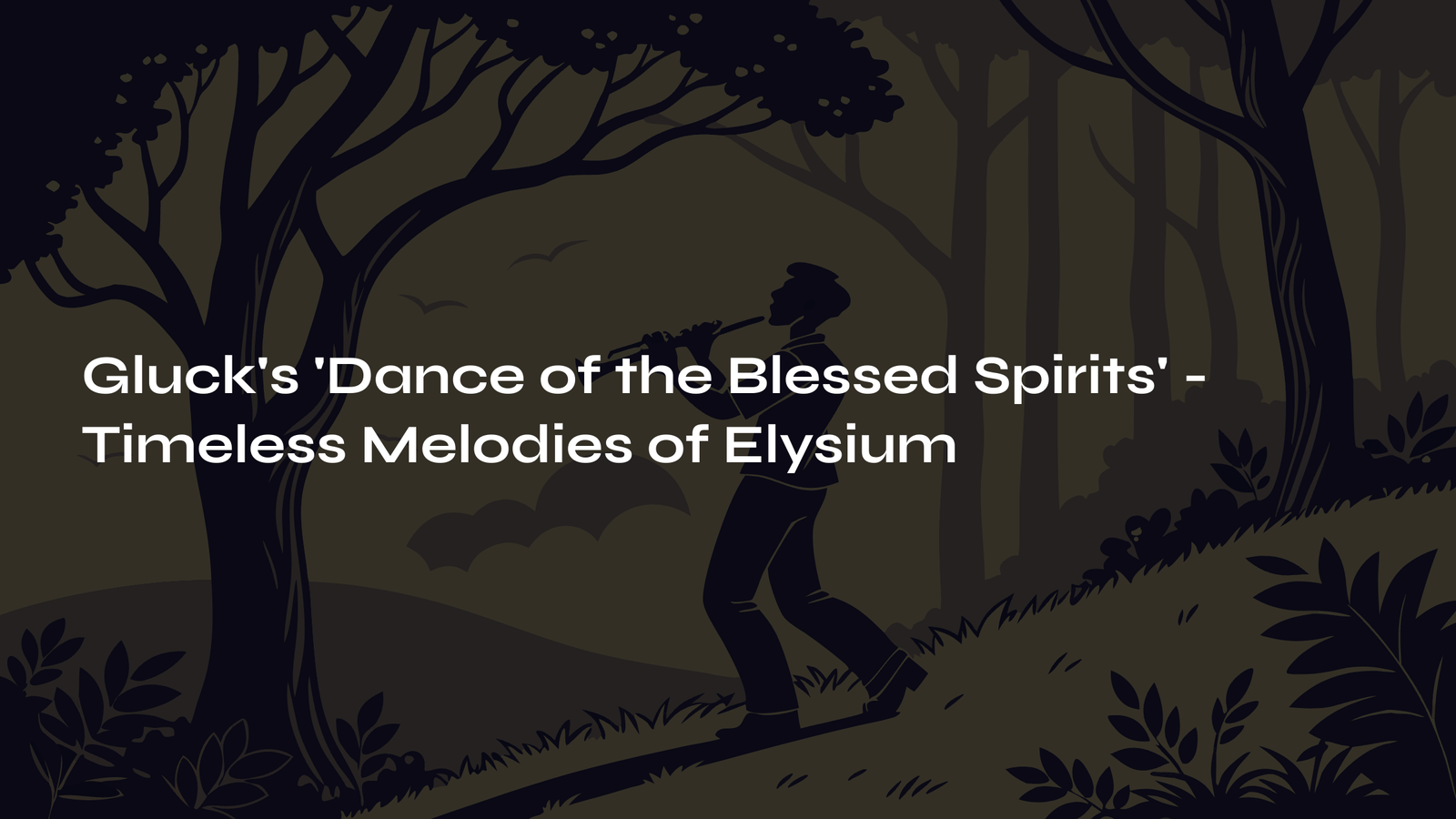Table of Contents
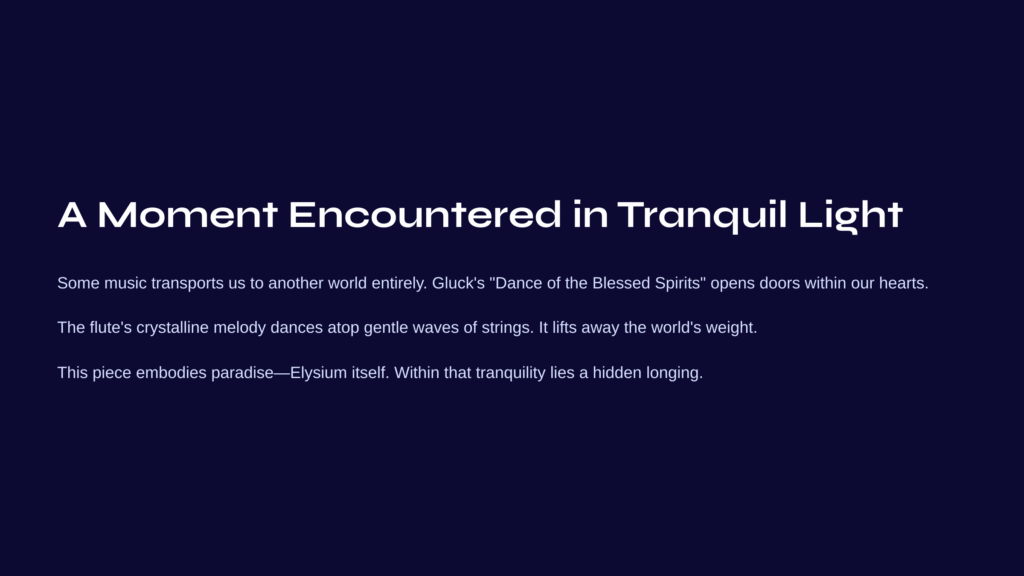
A Moment Encountered in Tranquil Light
Some music transports us to another world entirely. With just a few notes, it opens doors deep within our hearts and envelops us in an inexplicable peace. When I first heard Gluck’s “Dance of the Blessed Spirits,” I felt as though I were walking on clouds. The flute’s crystalline melody dancing atop the gentle waves of strings seemed like magic, momentarily lifting away all the weight of the world.
This piece is not merely a beautiful melody. It is the musical embodiment of the paradise humanity has always dreamed of—Elysium itself. Yet within that perfect tranquility lies a hidden longing that touches our hearts even more deeply.
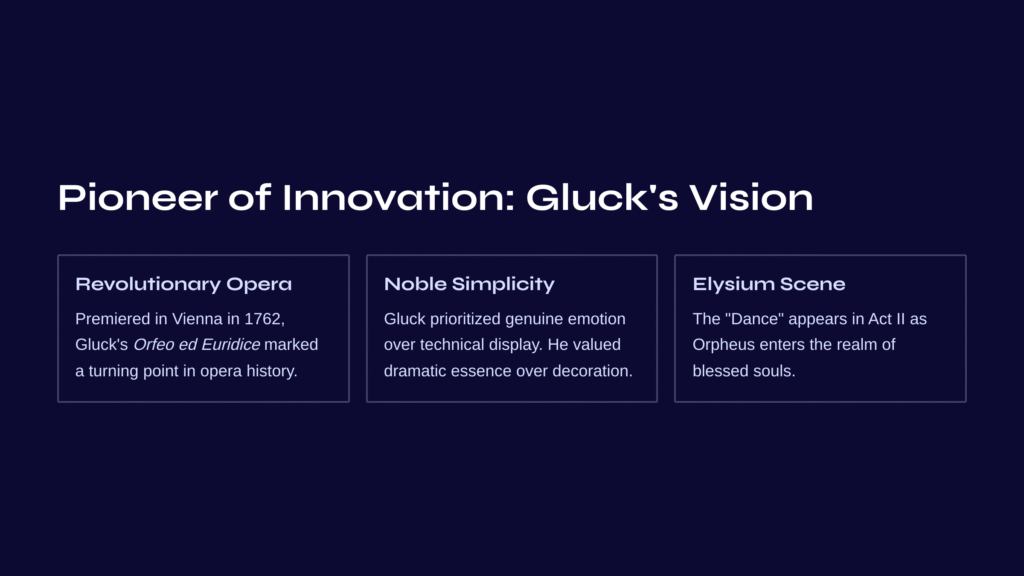
Pioneer of Innovation: Gluck’s Vision of a New Opera
Christoph Willibald Gluck’s *Orfeo ed Euridice*, premiered in Vienna in 1762, marked a crucial turning point in opera history. While the opera seria of the time was filled with elaborate vocal virtuosity and ornamental arias, Gluck boldly overturned these conventions. What he pursued was “noble simplicity”—prioritizing genuine emotion over technical display, and dramatic essence over decoration.
The “Dance of the Blessed Spirits” is performed in Act II, Scene II of the opera. After Orpheus has calmed the Furies of hell, he arrives at Elysium—the dwelling place of blessed souls. Gluck created special music for this moment. Before Eurydice’s entrance, this peaceful interlude guides the audience into the celestial realm.
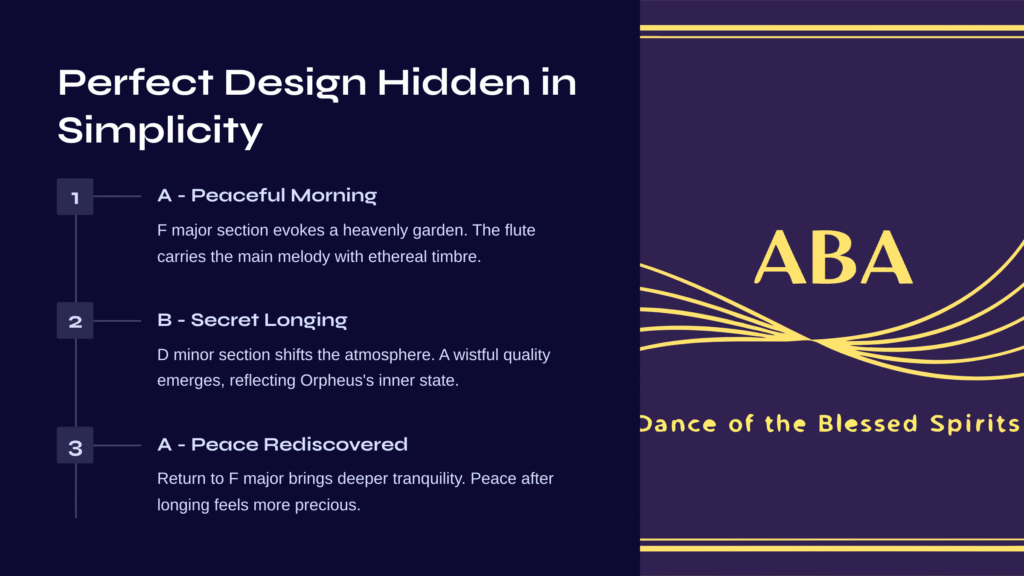
Perfect Design Hidden in Simplicity – The Beauty of Musical Structure
The structure of this piece is remarkably simple. It follows an ABA form—a ternary structure. Yet this very simplicity is where Gluck’s genius truly shines.
A – The Peaceful Morning of Elysium
The first A section, beginning in F major, evokes a heavenly garden bathed in golden sunlight. The flute carries the main melody, and this instrumental choice is profoundly meaningful. The flute’s transparent and ethereal timbre perfectly represents the existence of souls freed from earthly bonds.
The strings provide accompaniment with gentle triplet figures, creating the sensation of a soft breeze filtering through leaves. The harmony created by first and second violins, violas, cellos, and double basses achieves perfect balance through simplicity.
B – Whispers of Secret Longing
The middle section modulates to D minor, shifting the atmosphere. Though still beautiful, a wistful quality emerges. This likely reflects Orpheus’s inner state—for even the most beautiful Elysium cannot bring complete happiness without beloved Eurydice.
The flute melody becomes more emotional, and the string harmonies grow richer. Yet nothing becomes dramatic or passionate. Everything remains restrained and elegant.
A – Peace Rediscovered
The final A section returns to F major, but now that tranquility carries a different depth. The peace found after experiencing middle longing feels more precious and meaningful.
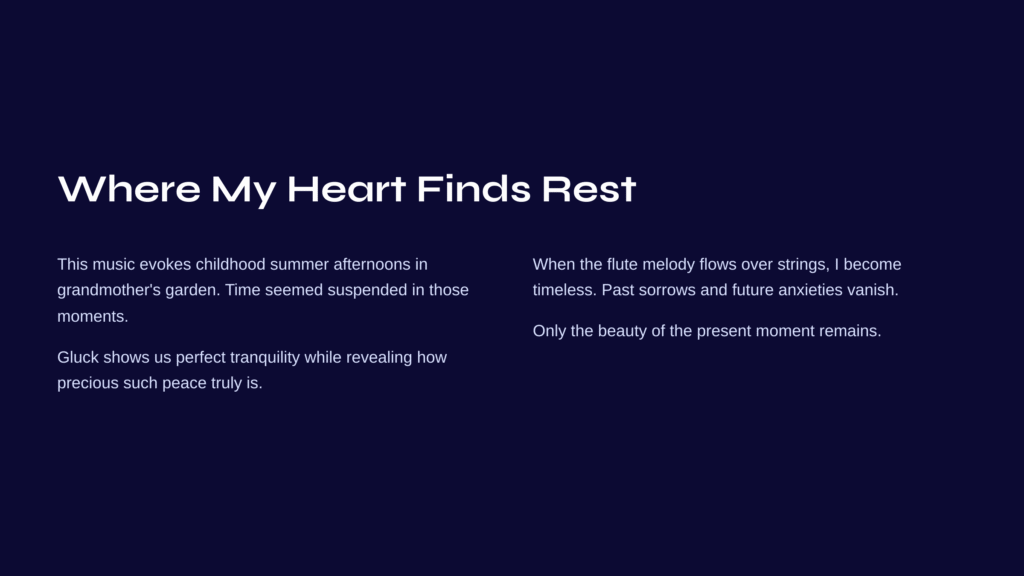
Where My Heart Finds Rest
Listening to this music, I often recall summer afternoons from childhood—those quiet, peaceful moments when I would wake from a nap in my grandmother’s garden. The world continued turning, but in that instant, time seemed suspended.
The emotion Gluck’s “Dance of the Blessed Spirits” evokes is similar. This music shows us what perfect tranquility looks like, while simultaneously making us realize how precious such peace truly is. For within it are dissolved humanity’s deepest longings and love.
Particularly when the flute melody flows over the strings, I feel as though I become some timeless being. Past sorrows and future anxieties temporarily vanish, leaving only the beauty of this present moment.
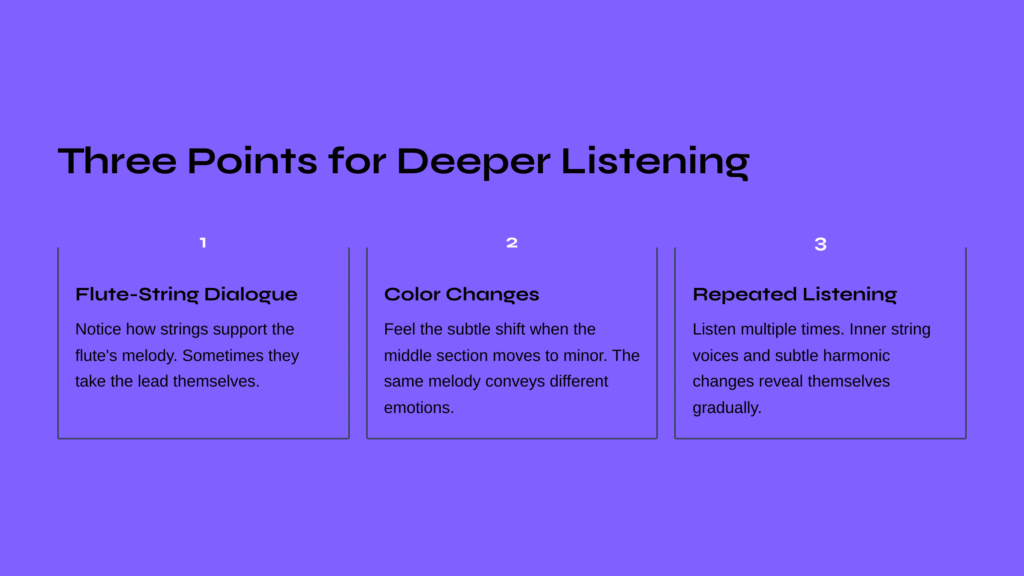
Three Points for Deeper Listening
To appreciate this piece more profoundly, consider these three aspects while listening.
First, pay attention to the dialogue between flute and strings. Notice how the strings support the flute’s main melody, and how they sometimes take the lead themselves. It’s like watching skilled dancers perform an ensemble piece.
Second, feel the subtle color changes when the middle section shifts to minor. The same melody conveys completely different emotions in major versus minor keys. This transformation reveals how delicate a composer Gluck truly was.
Third, I recommend listening to this piece repeatedly. Your first encounter overwhelms with overall beauty, but only through repeated listening can you discover detailed beauties. Particularly the inner voices of strings and subtle harmonic changes become audible only after multiple hearings.
When choosing a recording, I recommend chamber orchestra versions. Smaller ensembles better capture this piece’s intimate and graceful character than overly large orchestras.
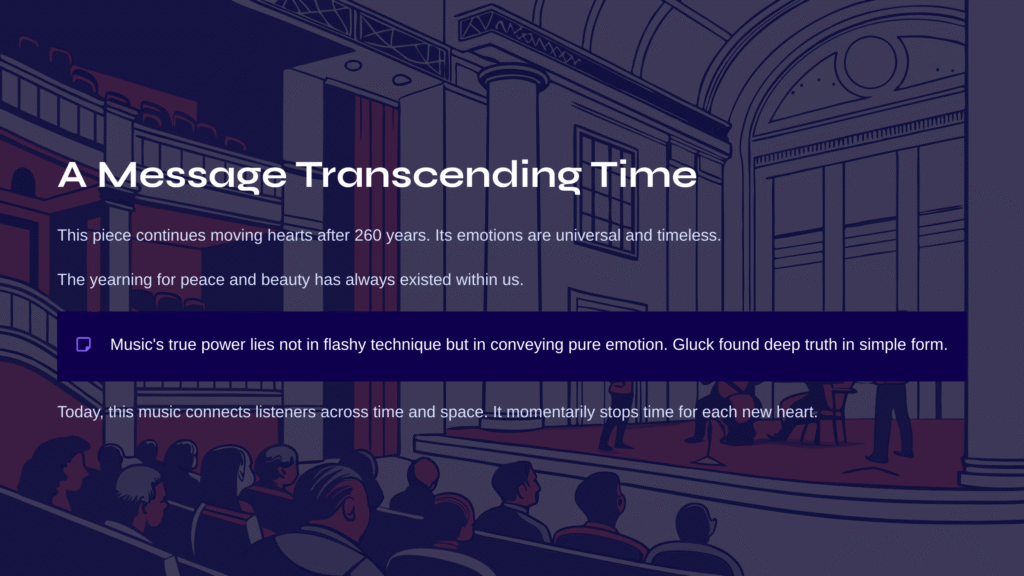
A Message Transcending Time
Gluck’s “Dance of the Blessed Spirits” continues moving our hearts after more than 260 years. This endures because the emotions it contains are universal, transcending eras. The yearning for peace, longing for love, and pursuit of beauty have always existed within human hearts.
Listening to this piece, I rediscover music’s true power. It lies not in flashy technique or complex structure, but in the ability to convey pure emotion. Gluck’s pursuit of “noble simplicity” exists precisely here. Finding the deepest truth within the simplest form—isn’t this the true power of art?
Today, this music is being performed somewhere. And someone listening to that melody is, like me, momentarily stopping time and feeling peace deep within their heart. Thus music connects us across time and space.
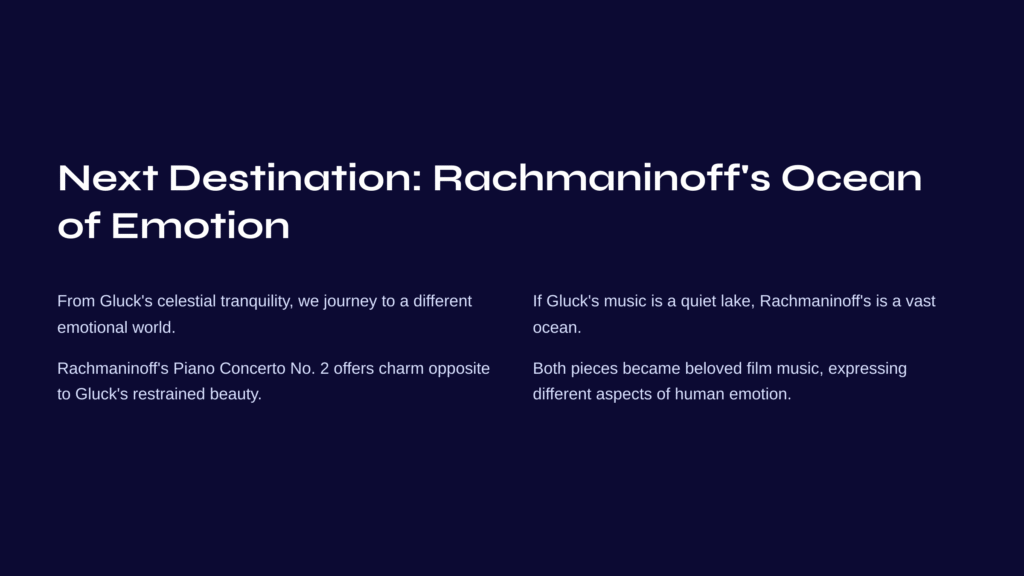
Next Destination: Into Rachmaninoff’s Ocean of Emotion
Having departed from Gluck’s celestial tranquility, how about journeying to a completely different emotional world? Rachmaninoff’s Piano Concerto No. 2, second movement, possesses charm opposite to Gluck’s restrained beauty. If Gluck’s music is like a quiet lake, Rachmaninoff’s is like a deep and vast ocean.
Composed in 1901, the Adagio sostenuto of this concerto’s second movement is in E major and stands as a monumental work marking the composer’s recovery from severe depression and return to composition. While Gluck pursued “noble simplicity,” Rachmaninoff poured the entire emotional spectrum into his music.
Particularly interesting is that both pieces have been beloved as film music. While Gluck’s peaceful melody expressed transcendent beauty, Rachmaninoff’s second movement perfectly represented suppressed love in the film *Brief Encounter*. This melody also became the foundation for Eric Carmen’s pop song “All by Myself.”
Having lingered in Gluck’s Elysium, let us now dive into Rachmaninoff’s deep emotional ocean. There we will newly discover just how complex and beautiful the human heart can be.
